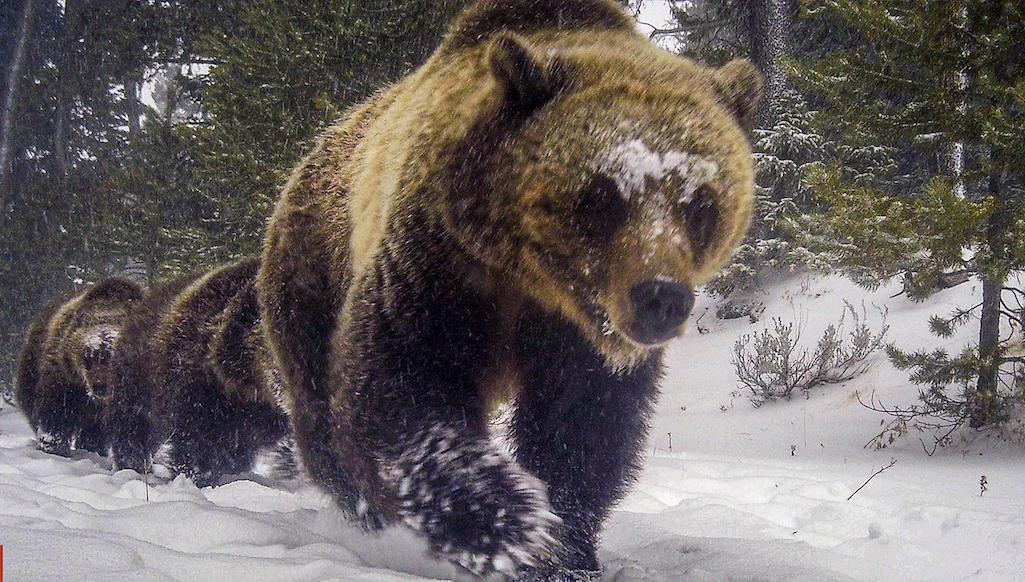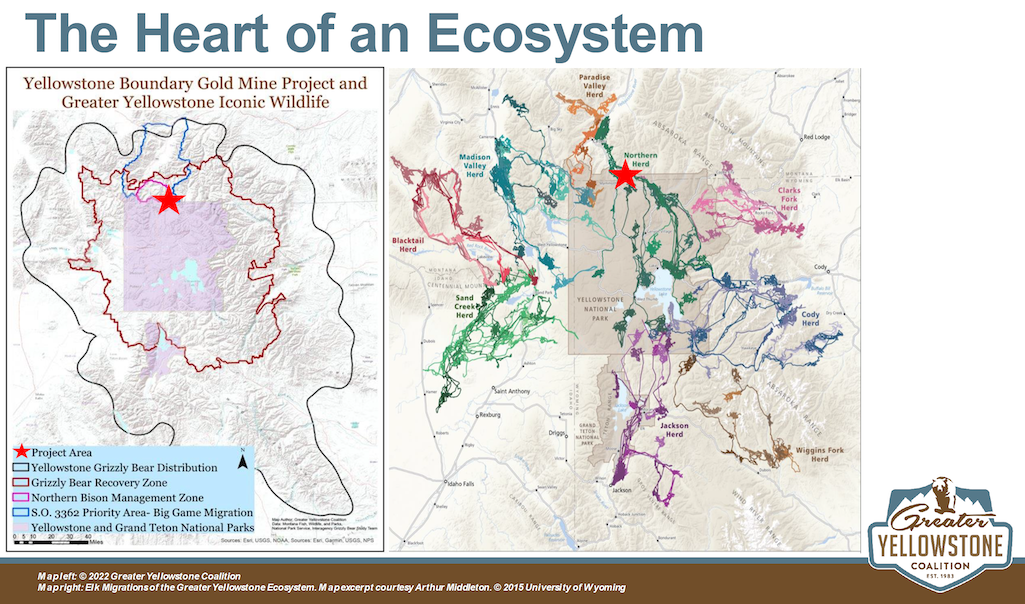
View into Yellowstone National Park from the Crevice Mountain Mine site/William Campbell
Nearly three decades after it took the involvement of Clinton administration to stop a gold mine from being developed on the northeastern corner of Yellowstone National Park, and five years after the Trump administration withdrew 30,000 acres north of the park from mineral development, a grassroots effort is underway to buy out a fledgling mine project that would be visible from the park and could theoretically send pollution down into the Yellowstone River.
By October 1 the Greater Yellowstone Coalition must raise $6.25 million to halt the Crevice Mountain Mine from burrowing into the mountain for gold and silver. Visible from the Roosevelt Arch at the park's North Entrance, the heavily forested landscape that would be affected by the proposed mine is roamed by grizzly bears, elk, mountain lions, and other wildlife.
"It's square in the middle of occupied grizzly bear habitat, is right in the middle of the Northern Range elk herd migration corridor," said Scott Christensen, executive director of the Coalition, on Wednesday. "It's got bighorn sheep and mule deer moving across it. It's within the northern bison tolerance zone. It has everything, wildlife-wise, that Yellowstone has. The proximity is so close. In fact, some of the lands in play here literally touch the boundary of the park. And then it also sits on the south flank of Crevice Mountain, it's perched directly above the Yellowstone River, right at the bottom of the Black Canyon of the Yellowstone. And so of course, if you start poking holes into a mountainside right above the Yellowstone River, there's a very high likelihood that [mine] drainage is going to occur down into the Yellowstone River."

Grizzly bears captured by camera trap on Crevice Mountain/William Campbell
The proposal, though not as far along, brings to mind the so-called New World Mine that Crown Butte Mines, a Canadian company, was poised to sink into the mountains just outside Yellowstone's Northeast Entrance. That project took its name from its location in the New World Mining District that dates to 1864, when prospectors started exploring the area. Concerns over how renewed operations might bring historic, as well as new, wastes into Yellowstone led to concerted efforts to halt the project, and even the United Nations took a stand by pointing to the proposed mine as the reason for placing Yellowstone on its list of “In Danger” World Heritage Sites.
In 1996, the Clinton administration came up with a solution. In return for $65 million in federal land and other assets, Crown Butte abandoned its plans for the mountains above Cooke City, Montana, and created a $22.5 million fund to clean up the mess that had been left behind by past mining operations.
"We’ve seen the negative impacts of mining on the Yellowstone boundary in the past," Yellowstone Superintendent Cam Sholly said in a statement. "Mining outside of the park, north of Yellowstone a century ago, left a legacy of toxic waste severely contaminating the Soda Butte Creek, making it the most polluted stream entering Yellowstone National Park. Instead of Soda Butte Creek, the impacts from this mine have the potential to contaminate the surface and groundwater that feeds directly into the Yellowstone River thereby displacing wildlife in the park and negatively affecting the visitor experience. Simply stated, Yellowstone National Park is recognized as one of the world’s most iconic national parks and we are concerned that the impacts from this mine could detrimentally impact park resources and values."
Five years ago, in the fall of 2018, then-Interior Secretary Ryan Zinke said 30,000 acres just north of Yellowstone would be off-limits to new mining claims for two decades.
Two years earlier, in 2016, then-Interior Secretary Sally Jewell and Under Secretary of Agriculture Robert Bonnie traveled to Chico Hot Springs, Montana, just north of the park, to announce that the Obama adminstration would block new mining claims on those 30,000 acres of U.S. Forest Service lands. The "segregation" of the lands Jewell and Bonnie announced was to be in effect for two years while the Departments of Interior and Agriculture evaluated whether to withdraw the land from new mining claims for an additional 20 years. The area is generally known as the historic Emigrant Gulch and Crevice mining districts in a region known as the Paradise Valley at the northern gates of Yellowstone.
In early October 2018, Zinke finalized the withdrawal of the acreage from mining for 20 years, subject to valid existing rights. That is the longest period possible under the secretary's authority, and there were efforts in Congress to pass legislation making the withdrawal permanent, something that occurred 2019 when President Trump signed the John D. Dingell Jr. Conservation, Management, and Recreation Act.
But the mining claims controlled by Crevice Mountain Mines were not covered by that withdrawal, and now the GYC is working to prevent the mine from moving forward. As of Wednesday the nonprofit organization had raised nearly $4 million towards the $6.25 million needed to seal the deal. Along with buying out the mining company's interests, GYC hopes to acquire another 300 acres of privately owned lands on the mountain and donate it all — roughly 1,700 acres — to the Custer Gallatin National Forest.
"Our goal, of course, is to ultimately try to get these private lands into public ownership," Christensen said. "There's a provision that we built into the Yellowstone Gateway Protection Act that states that any private lands that come into public ownership after the bill is passed are withdrawn from mineral entry. So the long-term play here is that by getting them into public ownership, they're forever protected from any future mining."
In a statement, a principal of Crevice, Michael Werner, said the company would move ahead with mining if GYC fails to raise the money by October.
“GYC came up with a palatable solution, and we said yes,” he said in a statement. “We have met all legal requirements to mine on Crevice Mountain, have millions of dollars already invested, and there are tens of millions of dollars to be made, but GYC was in the right place at the right time, with the right idea. If GYC does not meet our agreement, we will mine.”
Christensen said so far his organization has received donations from all 50 states ranging from $5 up to $1 million and that he was confident they would meet the deadline.
"We will get there by hook or by crook. I'm determined to get there," he said. "Failure is just not an option. The mining company has said if GYC fails to do this then they will mine, and that just cannot happen on the boundary of Yellowstone. We will find a way to get there and close the deal."






Add comment